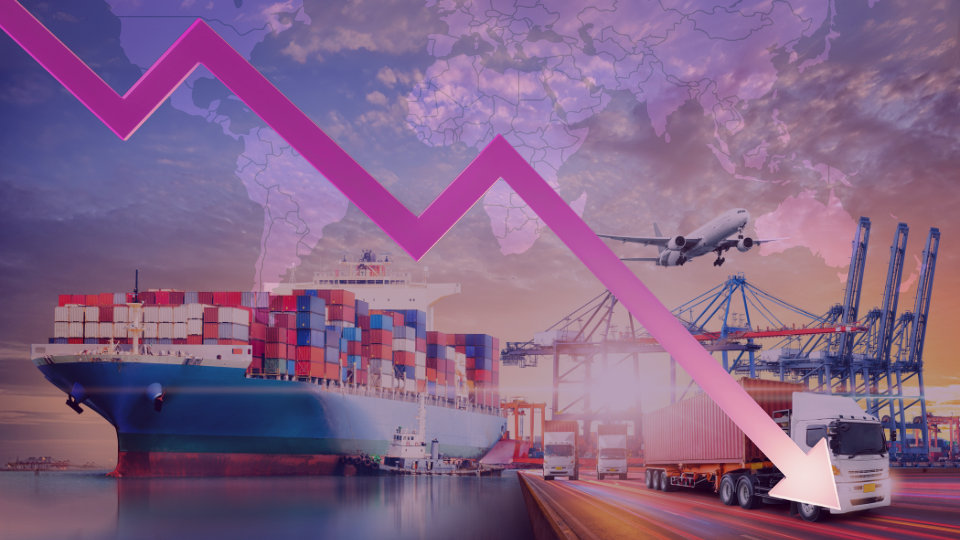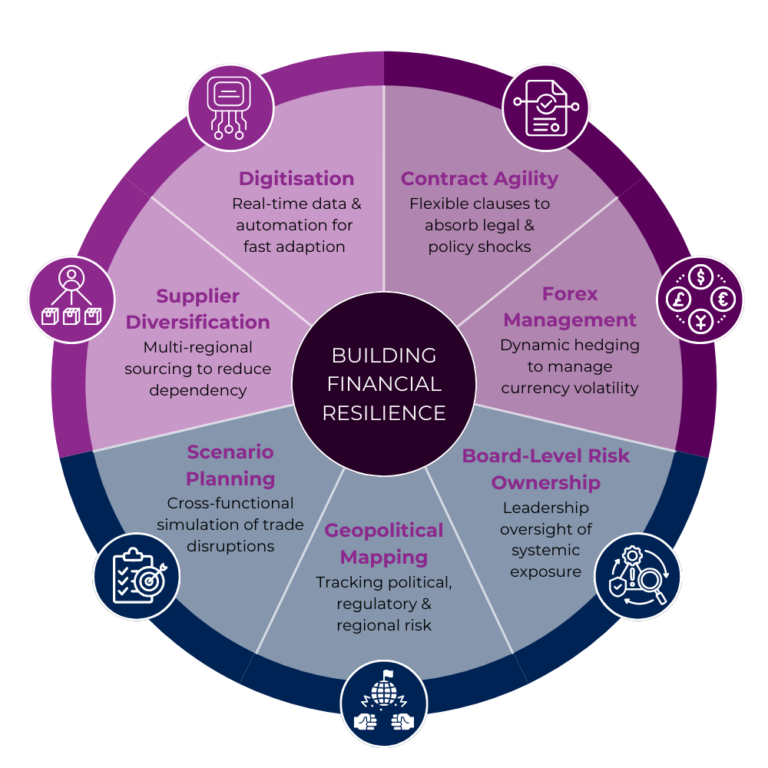Forex Management Insights
Safeguarding Global Supply Chains from Forex, Tariffs, and Geopolitical Risk
The rules of global trade have changed, and most businesses haven’t caught up.
-
Nicky Strydom
- 6 minutes read

For years, supply chains were built on predictability: falling freight costs, reliable sourcing, stable currencies. But that world is gone.
In its place: fragmented trade relationships, snap tariffs, politicised regulations, and currency volatility that hits pricing, contracts, and cash flow all at once.
Geopolitical events now ripple through financial systems in hours. Forex exposure can erode margin before treasury even sees the risk. And importers and exporters are being asked to deliver agility, certainty, and control, with less room for error than ever before.
This article, drawn from insights shared during Valufin’s webinar “The Supply Chain Meltdown – How to Protect Against Tariffs and Geopolitical Risk,” explores what forward-looking finance and operations leaders must do now.
From real-time treasury strategy to contract flexibility, currency alignment, and risk mapping, one thing is clear:
Resilience is no longer about buffer stock or backup suppliers; it’s about financial foresight.
Geopolitics is Now a Core Business Competency
Politics are no longer a background variable in global trade, they’re shaping how, where, and with whom business gets done.
Supply chains today are vulnerable not just to cost changes, but to strategic alliances, domestic policy agendas, and politically motivated regulation. A new export ban or sanctions list can invalidate contracts overnight.
“Geopolitical risk today goes far beyond war zones. It’s about legal uncertainty, regulatory divergence, sanctions exposure, and political instability embedded in your supply chain.” ~ Dr. Ian Oxnevad, Infortal Worldwide
Over the past decade, we’ve watched Brexit fracture the EU alignment, the U.S.–China trade war redraw sourcing maps, and Russia’s invasion of Ukraine disrupt global energy and payment systems. These aren’t isolated shocks, they represent a structural realignment of international trade.
And yet, many organisations still operate as if trade is governed by stable, multilateral rules. However, institutions like the WTO have lost power, and the trade landscape has become more fragmented, bilateral, and political.
The implications are tangible. A policy shift in a supplier’s country can delay goods, trigger penalties, or void contracts, often with no time to react.
To respond, businesses need more than awareness, they need geopolitical intelligence built into their operations. That means assigning responsibility for monitoring political risk, linking it to supply chain exposure, and making it part of treasury and commercial planning.
In today’s environment, geopolitical risk isn’t a headline; it’s an operating condition. And companies that track it in real time will outpace those reacting too late.
Tariffs Are the New Normal
Many businesses still treat tariffs as temporary obstacles, irritants to be absorbed or sidestepped until stability returns. But that mindset is no longer viable. Tariffs have evolved into strategic instruments, deployed not to protect industries but to project policy.
Recent trade policy has confirmed that tariffs are now tools of broader political and economic agendas. In the past 18 months alone, we’ve seen new tariffs imposed by the U.S. on China, Mexico, and Canada, often announced with little notice and justified on grounds ranging from national security to immigration.
This is not a return to traditional protectionism. It’s a shift toward real-time, politicised trade friction. And for companies reliant on cross-border goods flows, particularly importers and exporters, the implications are profound.
“Yes, the legal tools to challenge tariffs exist, but they’re too slow to matter. Companies can’t wait for resolution, they have to act on the assumption that the tariffs are here to stay.” ~ Paul Hardy, DLA Piper
Tariffs are no longer predictable or linear. They emerge suddenly, affect specific product categories or trade routes, and frequently bypass conventional dispute resolution channels. For importers, this can mean a shipment becomes uneconomic in transit. For exporters, it can mean contract renegotiations or cancelled orders; for CFOs, it introduces direct margin pressure.
The ability to adapt quickly is now a strategic necessity. Businesses should run scenarios that model different tariff configurations by region and product, assess legal exposure in their supply and sales contracts, and determine how quickly they can reroute goods, switch suppliers, or renegotiate terms.
Tariffs are no longer predictable, they’re strategic weapons deployed in real time.
Crucially, the tariff landscape must be integrated into cash flow, pricing, and FX exposure planning — especially for companies operating in multiple jurisdictions and currencies. It is not a separate risk category. It is embedded in the entire trade and treasury cycle.
In this new normal, success depends not on legal remedies but on operational agility. The companies that will thrive are those that can move faster than the policies disrupting them.
Tune in to discover how proactive planning, digital transformation, and integrated risk strategies can help businesses protect their supply chains, strengthen treasury practices, and stay competitive in a fragmented global landscape.
Digitisation: The Engine of Real-Time Risk Response
In a world of shifting regulations, sudden tariff announcements, and geopolitical instability, digitisation is no longer a value-add, it’s a lifeline.
Many businesses still operate with fragmented systems, spreadsheet-based tracking, and limited visibility across their supply chains. But without integrated, real-time data, organisations are essentially flying blind. When a policy change or disruption hits, they often learn about the impact too late, when the shipment is already delayed, the contract breached, or the margin lost.
“You need to know where your goods are, what markets they’re entering, and what policy risks they’re exposed to, before it’s too late to act.” ~ Bruce Trebble, Trebble Trading
Digitisation enables businesses to model risk, simulate outcomes, and pivot fast. It gives importers and exporters the ability to see, in real time, how a new tariff might affect routing decisions, how a change in currency value might impact cost per unit, or how an export control could delay clearance at port.
Global leaders are already showing what’s possible. For example, Singapore’s Networked Trade Platform integrates over 50 government and industry systems to enable seamless, near-instant customs processing. The UK’s Electronic Trade Documents Act now gives digital bills of lading the same legal standing as paper, accelerating cross-border operations while reducing administrative bottlenecks.
For companies engaged in international trade, digitisation is not just about speed, it’s about resilience. It’s the foundation for:
- Intelligent hedging strategies linked to real-time cash flow projections
- Supplier risk mapping based on jurisdictional exposure
- Scenario testing for shipping disruptions or sudden price shocks
- Legal and regulatory tracking across markets
This is especially critical for finance teams. Treasury decisions can no longer be based solely on historical data or quarterly forecasts. The new requirement is dynamic responsiveness, which is the ability to update assumptions as supply chain conditions evolve.
Businesses investing in the right platforms that are integrated, flexible, and built for uncertainty will be far better equipped to absorb shocks, protect margins, and outpace competitors when the next disruption arrives.
Forex Volatility - The Most Overlooked Supply Chain Threat
Among all the risks facing globally active businesses today, currency misalignment is arguably the most underestimated, and often the most damaging.
It doesn’t make headlines like tariffs or supply shortages. It doesn’t come with a formal announcement. But its impact is immediate: eroded profit margins, missed forecasts, delayed payments, and contract disputes. For importers and exporters, it strikes at the core of what keeps trade moving, price certainty and liquidity.
Foreign exchange exposure is no longer just about rate fluctuation. It’s about structural friction: contracts written in one currency, goods sourced or sold in another, and payments that must clear through multiple jurisdictions, all while markets shift in real time.
Aligning FX Policy with Cash Flow and Contracts
We now see suppliers in Asia requesting payment in RMB (short for Renminbi, China’s official currency and increasingly used in cross-border trade) instead of USD; Clients in the Middle East demanding euro-linked pricing; And companies rerouting goods through different ports — only to realise too late that their FX strategy doesn’t match the new flow of funds.
Treasury teams are left playing catch-up, trying to hedge exposures that weren’t visible until after the decision was made.
This is the gap that effective forex treasury management is designed to close.
“Resilience isn’t about fortifying everything — it’s about knowing what to flex, where to respond, and when to act.”
By moving from fragmented, reactive FX management to a coordinated, forward-looking currency strategy, organisations can:
- Map exposures across every leg of the supply chain and customer journey
- Align hedge policies with contract terms, shipping schedules, and invoice currencies
- Develop dynamic hedging strategies that evolve with business conditions
- Integrate FX insight into procurement, pricing, and cash flow planning — not just after-the-fact reporting
Dynamic Hedging in a Multipolar Currency Landscape
The shift to a more volatile, politically fragmented currency landscape is not slowing down. BRICS+ de-dollarisation, emerging market exposures, and regional payment systems are all reshaping how international trade is priced and settled.
For CFOs, treasurers, and commercial leaders, this means one thing: Currency decisions can no longer be siloed. They must be embedded in operational strategy, not just financial compliance.
The role of the forex treasury manager is now strategic. Those who treat FX as a living part of enterprise decision-making, not a reactive back-office function, will be best equipped to manage risk and protect margin in this new environment.
“We’re not witnessing a dollar collapse – but we are seeing a multipolar currency system emerge. That changes everything for global contracts and treasury policy.” ~ Sharon Constançon, CEO | Valufin
A 7-Point Framework for Building Financial Resilience
Responding to today’s supply chain challenges doesn’t mean building a bunker. It means designing for flexibility, visibility, and control, across financial, operational, and geopolitical dimensions.
Resilience is no longer defined by your ability to hold inventory or dual-source components. It’s measured by how quickly your business can assess a shock, model the impact, and pivot.
Organisations that are succeeding in this volatile environment share a common approach: They are embedding risk foresight into decision-making systems, not just post-incident analysis.
The following strategic priorities are emerging as essential pillars of supply chain resilience, particularly for businesses with cross-border flows and Forex exposure:
- Map geopolitical and regulatory exposure: Assess where your supplier and customer relationships intersect with unstable or politically complex jurisdictions. Don’t wait for a conflict, sanction, or regulatory shift to reveal those vulnerabilities.
- Rewire contracts for policy volatility: Ensure contracts are structured for adaptability, with clauses covering price adjustments, payment currency flexibility, and force majeure that reflects today’s realities.
- Digitise supply chain visibility: Invest in systems that allow you to monitor not just inventory or shipments but also financial exposure, policy changes, and currency impact in real time.
- Localise and diversify sourcing: Reduce dependency on single markets or high-risk corridors. Build optionality into your supplier base so you can reroute and reprice faster when disruption hits.
- Align Forex strategy with operations: Ensure your hedging approach reflects actual commercial flows, invoice currency, settlement timelines, and contractual exposure, not just top-line forecasts.
- Run scenario-based planning: Use geopolitical, economic, and currency simulations to model disruption across your financial and operational footprint. Build war-gaming into quarterly business reviews.
- Make risk ownership a leadership function: Treat risk management as a proactive, cross-functional responsibility. Assign clear accountability at the executive level, with treasury, procurement, legal, and finance working as an integrated unit.
Supply chain resilience isn’t about controlling every variable. It’s about knowing which levers you can pull and having the intelligence, tools, and governance to act quickly when needed.
In an era of overlapping disruptions, it’s the organisations that plan dynamically, respond decisively, and manage risk holistically that will emerge stronger, leaner, and more trusted by their customers and partners.

From Reactive to Resilient
Global trade is becoming more volatile, more political, and more complex. But it is also becoming more transparent — for those with the systems and capabilities to see what’s coming.
Businesses that treat resilience as a strategy, not a slogan, are already moving ahead. They’re linking FX policy to procurement, stress-testing contracts, and using treasury intelligence to protect pricing and preserve margins under pressure.
For importers and exporters, this is no longer optional. From the boardroom to the back office, operational teams and finance leaders must be equipped to anticipate disruption and act on it.
The organisations that will succeed are not those trying to eliminate risk entirely. They are the ones building the structure to absorb shocks, flex intelligently, and grow with confidence.
That’s the playbook now. The only question is whether your strategy is equipped to keep pace.
Volatility is a given. How you respond is not. Partner with forex treasury specialists who integrate financial strategy into every corner of your global operations.
Don’t let currency volatility erode your profits
Schedule a consultation with our experts and discover how you can protect your bottom line with efficient foreign exchange strategies.







